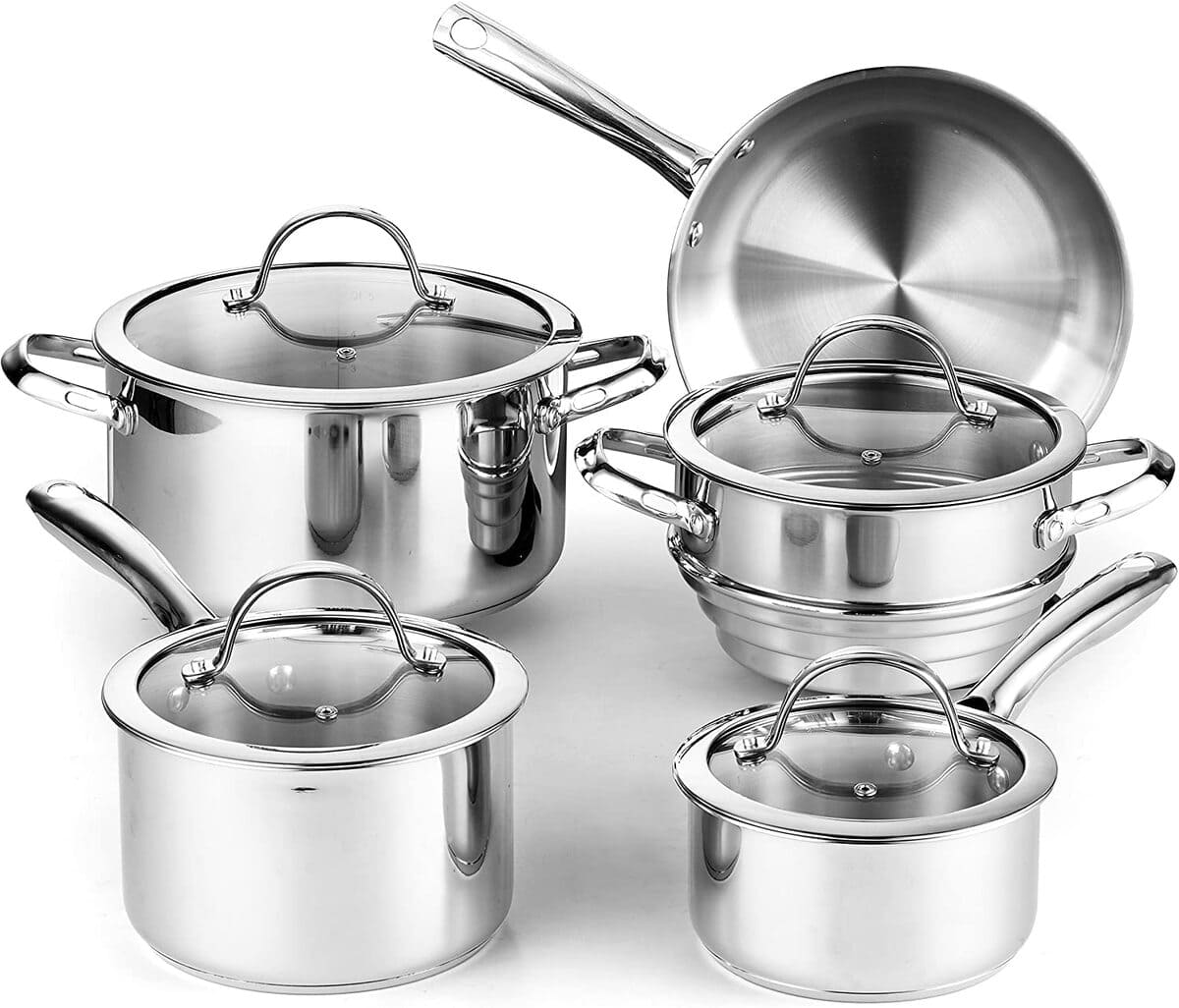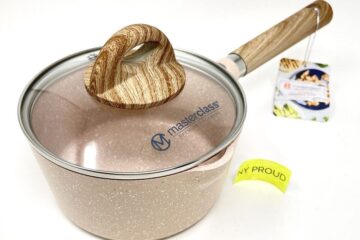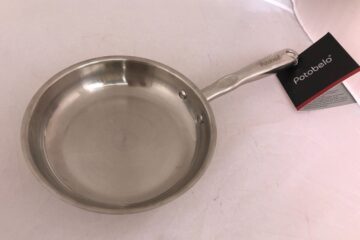Stainless steel cookware is a popular choice for many home cooks due to its durability and versatility. However, proper care is essential to ensure that these pots and pans last for many years. In this article, we will provide some practical tips on how to care for stainless steel cookware to keep it looking like new.
First and foremost, it is important to avoid using harsh chemicals and steel wool when cleaning stainless steel cookware. Instead, opt for mild soapy water or a mixture of vinegar and warm water to remove stubborn residue. For tough stains, baking soda and lemon can be used with a scrubber to gently clean the surface. Additionally, products like Bar Keeper’s Friend can help remove any discoloration or burnt-on food. By avoiding harsh cleaning methods, you can prevent scratches and other damage to the cookware’s surface.
Another important tip is to avoid putting stainless steel cookware in the dishwasher. While most stainless steel pots and pans are dishwasher safe, the high temperatures and harsh detergents can cause damage over time. Instead, wash them by hand with warm water and a non-abrasive sponge or cloth. This will help to preserve the cookware’s finish and prevent any scratches or dents. By following these simple tips, you can ensure that your stainless steel cookware stays in great condition for years to come.
Why Stainless Steel Cookware Needs Special Care
Stainless steel cookware is a popular choice for many home cooks due to its durability, versatility, and sleek appearance. However, it requires special care to maintain its quality and extend its lifespan.
One reason why stainless steel cookware needs special care is that it is prone to discoloration and staining. This can happen if the cookware is not cleaned properly or if it is exposed to high heat for prolonged periods. Additionally, acidic foods like tomatoes and citrus can cause discoloration if left in the cookware for too long.
Another reason why stainless steel cookware needs special care is that it can be easily scratched. This can happen if the cookware is cleaned with harsh chemicals or abrasive materials like steel wool. Even using metal utensils can cause scratches on the surface of the cookware.
Furthermore, stainless steel cookware can develop hot spots if it is not used and cared for properly. Hot spots are areas of the cookware that become significantly hotter than the rest of the surface, which can cause food to burn or cook unevenly.
To avoid these issues, it is important to take special care when using and cleaning stainless steel cookware. This includes avoiding the use of harsh chemicals or abrasive materials, using only non-metal utensils, and avoiding high heat for prolonged periods. Additionally, it is important to clean the cookware thoroughly after each use and to avoid leaving acidic foods in the cookware for too long.
Cleaning Stainless Steel Cookware
Stainless steel cookware is a popular choice for its durability and sleek appearance. However, it requires proper care to maintain its shine and prevent damage. Cleaning stainless steel cookware is an essential part of its care routine. Here are some tips for cleaning stainless steel cookware:
Hand Washing
Hand washing is the preferred method for cleaning stainless steel cookware. Here’s how to do it:
- Fill the sink with warm water and add a small amount of dish soap.
- Use a soft sponge or cloth to clean the cookware. Avoid using abrasive materials that can scratch the surface.
- Rinse the cookware thoroughly with warm water.
- Dry the cookware with a soft towel or cloth to prevent water spots.
Dishwasher
Stainless steel cookware is generally dishwasher safe, but it’s important to check the manufacturer’s instructions before putting it in the dishwasher. Here are some tips for cleaning stainless steel cookware in the dishwasher:
- Load the cookware on the top rack of the dishwasher.
- Use a mild detergent and the normal wash cycle.
- Do not use the heated dry cycle. Instead, remove the cookware from the dishwasher and dry it with a soft towel or cloth.
It’s important to note that some dishwasher detergents can be harsh and may damage the cookware’s surface. If you notice any discoloration or damage, stop using the dishwasher and switch to hand washing.
Seasoning Stainless Steel Cookware
Why Seasoning is Important
Seasoning stainless steel cookware is an important step to ensure that it lasts a long time and performs well. The seasoning process involves heating the pan with oil to create a non-stick layer that prevents food from sticking to the surface.
When stainless steel cookware is not seasoned, it can be difficult to cook with and clean. Food may stick to the surface, and the cookware may become discolored or develop stains. Seasoning creates a protective layer that prevents food from sticking and makes cleaning easier.
How to Season Stainless Steel Cookware?
To season stainless steel cookware, follow these simple steps:
- Wash the pan with warm, soapy water and a sponge. Rinse and dry thoroughly.
- Heat the pan over medium-high heat for about 2 minutes.
- Add a thin layer of vegetable oil to the pan (about 1/8 inch).
- Use a paper towel to spread the oil evenly over the surface of the pan, including the sides.
- Heat the pan for another 2-3 minutes, or until the oil begins to smoke.
- Turn off the heat and let the pan cool completely.
- Wipe the excess oil off the surface of the pan with a paper towel.
- Store the pan in a cool, dry place.
Repeat this process every few months to maintain the non-stick layer and prevent food from sticking to the surface of the pan.
It’s important to note that not all stainless steel cookware can be seasoned. Check the manufacturer’s instructions before attempting to season your cookware. Additionally, be sure to use a high smoke point oil, such as vegetable or canola oil, for seasoning.
Storing Stainless Steel Cookware
When it comes to storing stainless steel cookware, it’s important to take proper care to ensure that it remains in good condition for years to come. Here are a few tips for storing your stainless steel cookware.
Optimal Storage Conditions
Stainless steel cookware should be stored in a cool, dry place to prevent moisture from building up and causing rust or corrosion. Ideally, it should be stored in a cabinet or pantry away from direct sunlight and heat sources, such as stovetops and ovens.
If you’re short on cabinet space, consider hanging your stainless steel cookware from a pot rack or hooks on the wall. This not only saves space but also adds a decorative touch to your kitchen.
Avoiding Scratches and Dings
To prevent scratches and dings, it’s important to stack your stainless steel cookware properly. When stacking pots and pans, place a layer of paper towels or felt pads between each piece to prevent them from rubbing against each other. This will also help prevent scratches and dings caused by metal-on-metal contact.
Avoid storing heavy items on top of your stainless steel cookware, as this can cause dents and dings. Instead, store it on a sturdy shelf or in a cabinet with plenty of space.
Maintaining the Appearance of Stainless Steel Cookware
Stainless steel cookware is a popular choice for many home cooks due to its durability and resistance to rust and corrosion. However, over time, stainless steel cookware can become discolored, stained, or lose its shine. Proper maintenance is key to keeping your stainless steel cookware looking like new. In this section, we will discuss how to polish stainless steel cookware and remove stains and discolorations.
Polishing Stainless Steel Cookware
Polishing your stainless steel cookware is essential to maintain its shine and prevent discoloration. Here are some tips to polish your stainless steel cookware:
- Use a soft cloth or sponge to apply a small amount of stainless steel cleaner or polish.
- Rub the cleaner or polish in a circular motion, following the grain of the steel.
- Wipe off any excess cleaner or polish with a clean cloth.
- Rinse the cookware with warm water and dry it with a clean towel.
Removing Stains and Discolorations
Stains and discolorations can occur on stainless steel cookware due to heat, food residue, or hard water. Here are some tips to remove stains and discolorations:
- Soak the cookware in warm, soapy water for at least 30 minutes.
- Use a non-abrasive sponge or cloth to scrub the stains or discolorations.
- For stubborn stains, mix equal parts vinegar and water and soak the cookware for several hours.
- Rinse the cookware with warm water and dry it with a clean towel.
In addition to these tips, it’s important to avoid using abrasive cleaners or steel wool on your stainless steel cookware, as they can scratch the surface and cause discoloration. By following these simple steps, you can keep your stainless steel cookware looking like new for years to come.
Conclusion
In conclusion, caring for stainless steel cookware is essential to ensure its longevity and maintain its appearance. By following the tips outlined in this article, users can keep their cookware looking like new for years to come.
One of the most important things to keep in mind when caring for stainless steel cookware is to avoid using abrasive materials that can scratch or damage the surface. Instead, opt for gentle cleaning solutions such as warm water and mild soap, or vinegar and baking soda for tougher stains.
Another important factor to consider is the way in which the cookware is stored. To prevent scratches and other damage, it is recommended to stack pots and pans with a layer of padding in between each piece.
Additionally, it is important to avoid exposing stainless steel cookware to extreme temperatures, such as placing a hot pan in cold water. This can cause warping and other irreparable damage.
Overall, with proper care and maintenance, stainless steel cookware can last for many years and provide users with reliable and efficient cooking performance.



